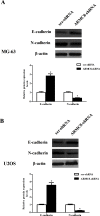Armadillo Repeat-Containing Protein 8 (ARMC8) Silencing Inhibits Proliferation and Invasion in Osteosarcoma Cells
- PMID: 27712595
- PMCID: PMC7838741
- DOI: 10.3727/096504016X14685034103392
Armadillo Repeat-Containing Protein 8 (ARMC8) Silencing Inhibits Proliferation and Invasion in Osteosarcoma Cells
Abstract
Armadillo repeat-containing protein 8 (ARMC8) plays an important role in regulating cell migration, proliferation, tissue maintenance, signal transduction, and tumorigenesis. However, the expression pattern and role of ARMC8 in osteosarcoma are still unclear. In this study, our aims were to examine the effects of ARMC8 on osteosarcoma and to explore its underlying mechanism. Our results demonstrated that ARMC8 was overexpressed in osteosarcoma cell lines. Knockdown of ARMC8 significantly inhibited osteosarcoma cell proliferation in vitro and markedly inhibited xenograft tumor growth in vivo. ARMC8 silencing also suppressed the epithelial-mesenchymal transition (EMT) phenotype, as well as inhibited the migration and invasion of osteosarcoma cells. Furthermore, knockdown of ARMC8 obviously inhibited the expression of β-catenin, c-Myc, and cyclin D1 in MG-63 cells. In conclusion, this report demonstrates that ARMC8 silencing inhibits proliferation and invasion of osteosarcoma cells. Therefore, ARMC8 may play an important role in the development and progression of human osteosarcoma and may represent a novel therapeutic target in the treatment of osteosarcoma.
Conflict of interest statement
The authors declare no conflicts of interest.
Figures






References
-
- Ward E.; DeSantis C.; Robbins A.; Kohler B.; Jemal A. Childhood and adolescent cancer statistics, 2014. CA Cancer J. Clin. 64:83–103; 2014. - PubMed
-
- Edward E. D.; Rosdiana N.; Farhat O. R.; Lubis B. Prevalence and risk factors of hearing loss in children with solid tumors treated with platinum-based chemotherapy. Paediatr. Indones. 55:121; 2015.
-
- Fiori R.; Vivo D. D.; Scarano A. L.; D’Onofrio S.; Calabria E.; Giovanni S. Local invasion of jaw osteosarcoma. Int. J. Case Rep. Images 6:224–227; 2015.
-
- Kaya M. Prognostic factors for osteosarcoma patients. In Ueda T.; Kawai A., eds. Osteosarcoma. New York: Springer; 2016:73–79.
MeSH terms
Substances
LinkOut - more resources
Full Text Sources
Other Literature Sources
Medical
Research Materials
